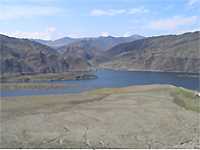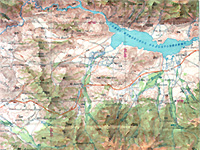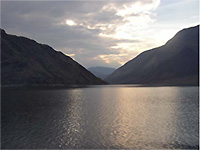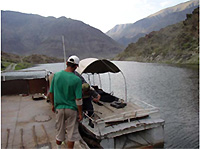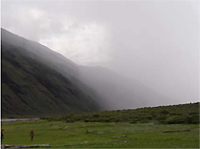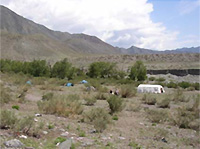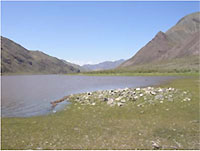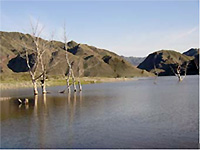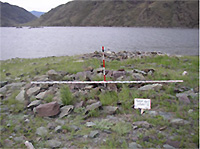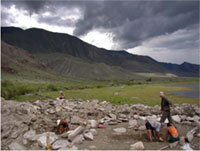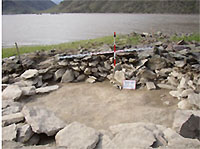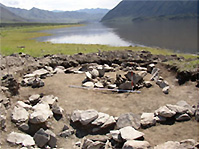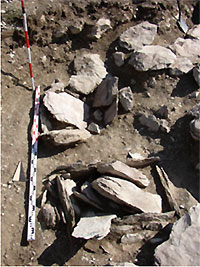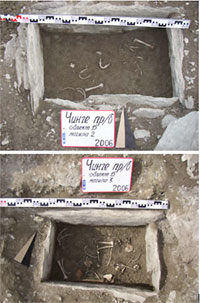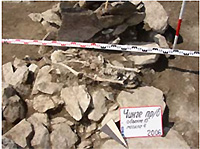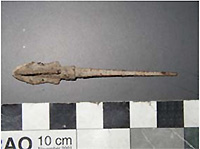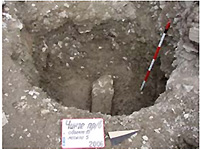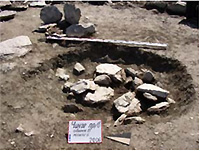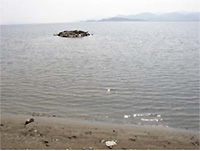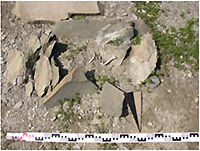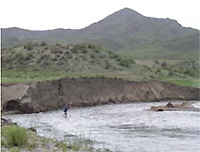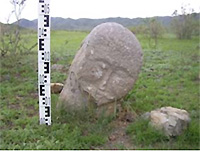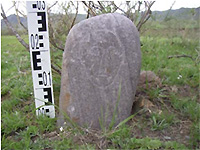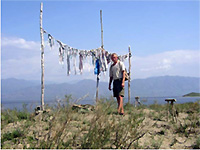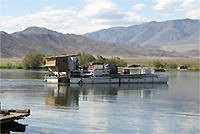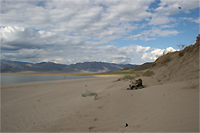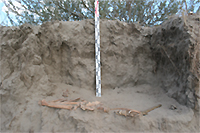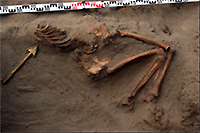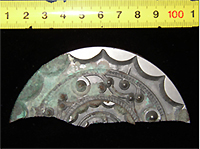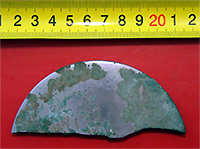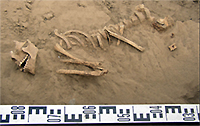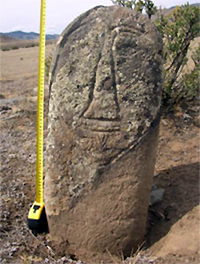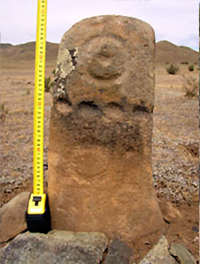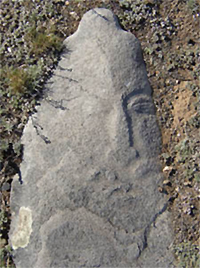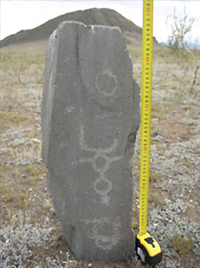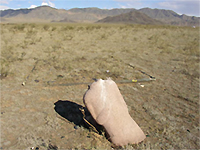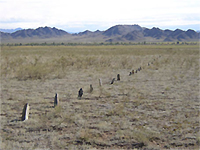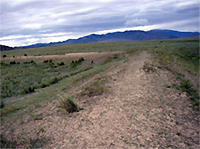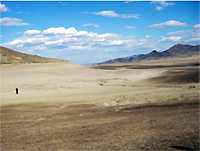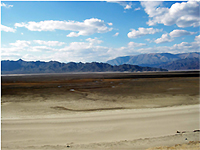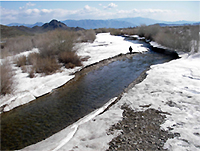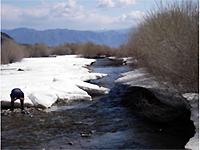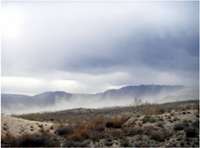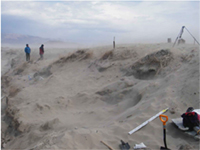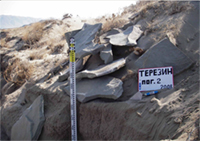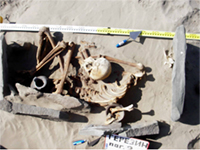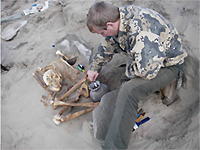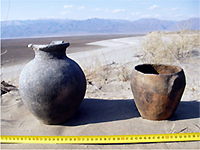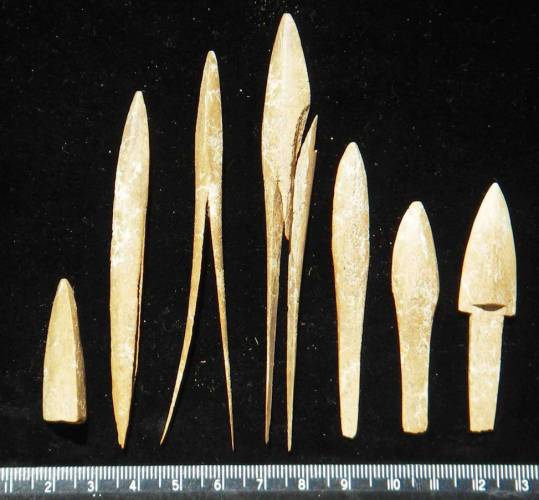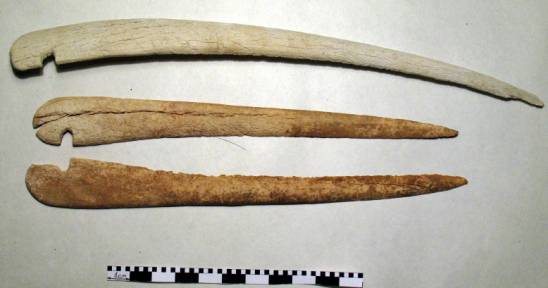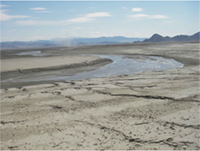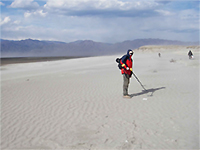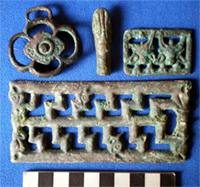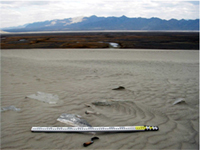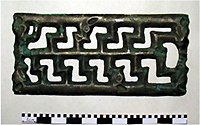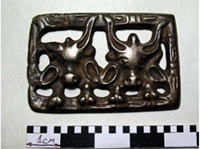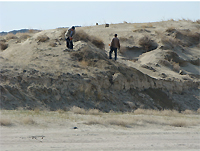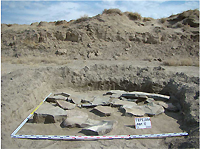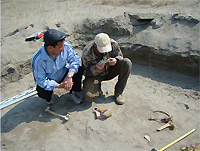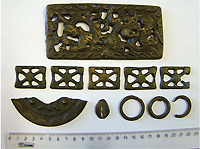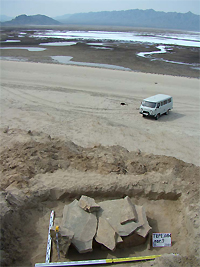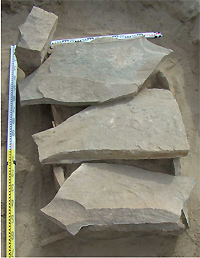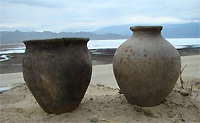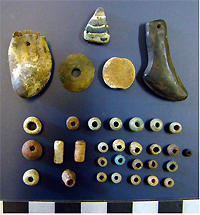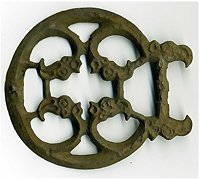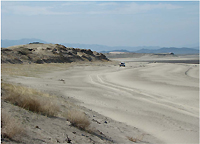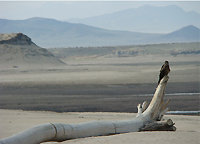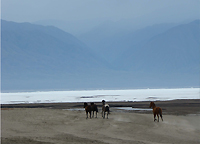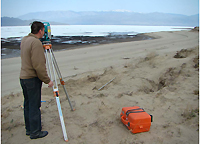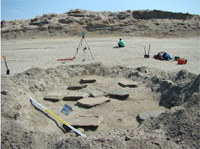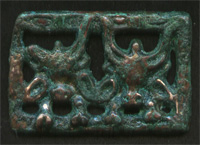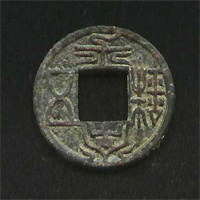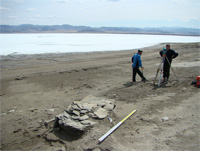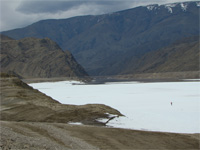Search and excavation of ancient Sarmatian, Hunnish and Turkic tombs
| 2006 | 2007 | 2008 | 2009 | 2010 | 2011 | 2012 | 2015 | 2016 | 2017 | 2018 | 2019 | 2020 | 2022/23/24 |
Starting point
In Central Tuva, Russian Federation, a dam has been built in the late 1980s for hydroelectric purposes leading to the emergence in the region of Sajano-Susenskoe of an artificial lake. (Fig.1+2) The lake is continuously growing in size. The region of Sajano-Susenskoe is of high historic and archaeological importance, since it is home to numerous ancient Scythian and Turkic tombs. Also ancient Turkic stone figures are to be found as well as on the mountain slopes petroglyphs from the Bronze Age. Since the construction of the dam, the area is annually under water and many, mainly Scythian tombs, have been flooded. Emergency excavations are only possible in summer when water is low.
| Fig. 1: The artificial lake Sajano-Šušenskoe | Fig. 2: Lake Sajano-Šušenskoe in Central Tuva |
Relevance
Many Scythian tombs have been surveyed and excavated in the framework of emergency excavations since the late 1980s, but little has been published. The Turkic tombs have so far been little studied and even less has been published on them so far. The Turkic tombs are located a bit higher and a bit further from the floor of the former, now flooded valley than the Scythian ones and have been thus - so far - less threatened and/or damaged by the raising level of the lake than the first ones. However, the continuously rising of the water level now also threatens these Turkic tombs.
Goals
The main, most urgent goal is to discover so far unknown Turkish tombs, to survey them systematically and to selectively excavate the most promising, unlooted ones. Also the discovery of tombs from the Bronze Age can be expected. The secondary goal is to find unknown Turkic stone figures and also Bronze Age petroglyphs.
Project leader
Pavel Leus, Doctoral Candidate at the Free University Berlin and member of the Interregional Association of Archaeologists, St. Petersburg. Scientific Collaborator in The Committee for the Cultural and Historical Preservation of Historical Monuments of the Republic Tuva.
In cooperation with:
The Interregional Association of Archaeologists, St. Petersburg.
The Committee for the Cultural and Historical Preservation of Historical Monuments of the Republic Tuva.
Report on the Field Explorations Regarding the Project „Archaeological Investigations of Old-Turkish Antiquities at the Sajano-Šušenskoe Reservoir in Tuva in the Year 2006
(Russian Federation)“
Thanks to the generous support of The Society for the Exploration of EurAsia, a survey, as well as the excavation of a burial mound, could be executed in the summer of 2006 in the framework of first field explorations for a research project regarding the investigation of locations of old-turkish finds at the Sajano-Šušenskoe Reservoir in Tuva (Russian Federation).
| Fig. 1 The Reservoir in Front of the Sajan-Valley of the Enisej | Fig. 2 A Small Ferry on the Reservoir |
The archaeological exploration in this area initially began much later than in most of the other parts of Central Asia, for the territory, which today is known as autonomous Republic Tuva, did not belong to the Russian czarist empire, and was only annexed to the Sowiet union in 1944. First archaeological excavations took place at the beginning of World War I and were continued as late as the 1920s, when exclusive interest was directed toward the Scythian Kurgans in the north of Tuva, where Russian colonists had been living since the 19th century.
Archaeology had a noticeable upturn only after the World War II, when, in several parts of Tuva, first scheduled explorations of the territory and excavations were undertaken by S owiet scientists. The building of the Sajano-Šušenskoe Reservoir was the incentive for archaeological explorations in the construction area, which encompassed a large part of central Tuva. During the grading and building work, numerous excavations were executed at find sites there and in the Sajan Valley of the Jenissej that later were flooded by the water of the reservoir. The recovery excavations lasted more than 20 years and were of great importance for Scythian archaeology; however, their results were only partially made public.
Even though in the course of this research hundreds of archaeological monuments were explored, the number of medieval Kurgans involved was low. South and east of the reservoir, several complexes with old-turkish and old-kirghiz burial sites were discovered and excavated. The northern and north-western banks however remain – with exception of an excavation on the left bank of the river Cinge, where in the 1970's several early Scythian burial mounds were uncovered – unexplored to this day. This territory is very hard to reach outside the frost period. The summit of the Sajan Mountains and the reservoir leave few possibilities to penetrate this territory. There is only a crossing over the Jenissej by ferry or the difficult passage over the mountains on horseback. Yet the arranging for fuel availability alone is here, far away from Kyzyl, capital of Tuva, a most complicated and cost-intensive logistical challenge, so that the motor boats on the reservoir rarely operate.
In the summer of 2006, our team was able to cross over to the other bank of the river Jenissej, near the estuary of the small tributary Cinge, and to search there for medieval Kurgans and stone portraits. Because of the extreme weather conditions with heavy downpours, the planned work unfortunately could not be accomplished as originally intended.
| Fig. 3 The Storm from the Sajan Valley of the Enissej | Fig. 4 The Expedition Camp on the River Cinge |
In order that the southern Sibirian cities down-river would not be flooded, the water this year was already dammed up very high in the reservoir, so that most of the archaeological monuments were already under water at the time of our arrival.
| Fig. 5 A Flooded Burial Mound | Fig. 6 The Flooded Mouth of the River Cinge |
Therefore a Kurgan from the burial ground Cinge was chosen for the excavation. This is situated on the second terrace of the bank of the Jenissej. It consists of more than 20 tumuli that belong to various historical epochs.
Kurgan 15 of the necropolis corresponded in its construction to the already familiar medieval kurgans in Tuva. It possessed a round deposit of rough stone and rubble with a diameter of 6 m and a height of 50 cm. Its base showed no recognizable reinforcement of larger stones, which would have been typical for burial sites of the Scythian period. A stele of stone in close approximity furthermore made it seem very likely that the „kurgan“ had been created in the old-Turkish period.| Fig. 7 Object 15 Before the Excavation | Fig. 8 Object 15 During the Excavation Work |
After uncovering the stone deposit, it was observed that the hillock was larger than initially assumed. The base and parts of the deposits were probably buried by stone rubble from mud slides that descended from the ravine situated on the opposite side. Thus it was found in the course of the excavation that the „kurgan“ measured approximately 10 m in diameter and approximately 1,l m in height. The round base of the burial mound was fortified with large stones and from the south covered by the rubble of a neighboring kurgan. It became obvious that originally this was an early Scythian kurgan of the so-called Aldy Bel'-Culture (7th – 5th cent. B.C.), modified in the Middle Ages in the course of a later burial.
| Fig. 9 N.W.-Sector and the Base after Excavation | Fig. 10 The Object after Complete Excavation |
The excavations brought to light six graves altogether. Two of them, graves 2 and 3, were situated in the west, directly outside the fortification ring of the kurgan. In each grave a small stone chest of stone slabs was found, each of which contained a child's grave, totally plundered by grave robbers. A first anthropological attention to the bone finds from the graves showed that in each box children between the ages of 1 – 2 years were laid to rest. The position of the dead found, as well as the composition of the grave inventory could no longer be determined.
| Fig. 11 Graves 2-3 Before the Excavation | Fig. 12 Graves 2 and 3 (below) After the Excavation |
In the center of the burial mound, on the original surface, two further burial sites (graves 1 and 4) were uncovered. Grave 1 was also a stone chest with remains of a child burial, the bones of which, because of regular flooding, were in very poor condition. The neighboring grave 4 showed a medieval after-burial. The bones of the dead were in bad condition as well.
| Fig. 13 The Uncovered Grave 4 | Fig. 14 The Tip of an Arrow from Grave 4 |
Skull and pelvis were broken or gone because of the flooding as well as the weight of the stone deposits, so that the exact determination of age and sex was no longer possible. In all likelihood this is the burial of a half-grown boy, who was placed on his back, with his head in the north-westerly direction. At a distance of 15 cm from the left elbow, a well-preserved three-wing iron arrow tip was found. Grave 4 can be dated from the old-Turkish period in the 6th – 8th cent.
In the northern section of the kurgan grave 5 was discovered, the excavation of which had to be abandoned in a depth of 1,4 m however, because the water level of the reservoir had reached the burial field, and the rising water was already visible in the burial pit. For this reason, burial site 5 was filled in again, and also at grave 6, which was discovered in the center of the hill, the actual main burial site of the hill, excavation was not continued because of its estimated depth. Both burial sites apparently were not plundered, because no shaft by robbers could be found. Excavations will be continued here in 2007.
| Fig. 15 Grave 5 | Fig. 16 Grave 6 |
Further investigation of the shore of the reservoir in the framework of a survey showed convincingly that the destruction of the archaeological find sites here is progressing on a great scale and with great speed.
| Fig. 17 A Flooded Kurgan | Fig. 18 A Destroyed Stone Chest from the Scythian Period. |
On the western and southern shore, several flooded and destroyed stone chests of the Scythian period, as well as burial mounds built of stone were discovered.
The search for unknown, as yet undiscovered old-Turkish monuments was continued afterwards south-west of the reservoir, since this territory is not threatened by floods and, as of now, also totally unexplored. Thus a heretofore unknown old-Turkish find with stone walls and steles was discovered on the left bank of the river Caa-Hol', in the area of Šoluk-Hovu. The complex of Šoluk-Hovu is situated approximately 2,5 km north of the village Ak-Durug and 500 m west of the river Caa-Hol'. It consists of six square stone enclosures that extend in a south-north alignment.| Fig. 19 River Caa-Hol' | Fig. 20 Šoluk-Hovu, Statue in Front of Enclosure 1 |
The enclosures of 1,8 x 1,8 m to 3 x 3 m in size were erected from stone slabs, placed on end. In front of three constructions (enclosures 1, 3 and 6) statues in human form had been placed – always in front of the east side of the enclosure and facing east. The complex Šoluk-Hovu I can be dated from the old-Turkish period ( 6th - 8th cent.).
|
||
| Fig. 21 Šoluk-Hovu, Statue in Front of Enclosure 6 |
|
Such statues, often made very carefully, have been known to exist in different areas of central Asia, where they are connected to the First and Second Turkish Khaganat by most scientists. Tuva, which was incorporated in the First Turkish Khaganat around 555 A.D., also possesses a not insignificant number of these sculptures; thus today approximately 200 objects are known - most of them in the south and in the west of the autonomous republic. However, considerably more statues were found in Mongolia, in the Altaj and farther west. The complex of Šoluk-Hovu I enlarges the distribution area of this kind of medieval monument in central Asia. The survey will be continued here in 2007.
On the bank of the river Cinge, 500 m east of complex Šoluk-Hovu I, a partially-destroyed funeral site was discovered. Because of the erosion of the river bank, bones of a human skeleton were visible in the embankment; above, no traces of a burial site or of a mound were recognizable. It was probably a shallow grave, which in view of the vegetation in this area in most cases can only be found thanks to a coincidence; this is why until now only a few shallow graves have been discovered in Tuva. The difficulty in recognizing this form of grave, which not only presented a problem for today's archaeologists, but also for earlier grave robbers, renders the investigation of the burial site of Šoluk-Hovu II most important. It is entirely possible that this find represents part of a field of shallow graves, which would be an archaeological sensation for Tuva. The uncovering of this burial site and the search for further shallow graves in the surrounding area are planned for the upcoming campaign as well.
|
||
|
Fig. 22 The Project Leader Pavel Leus in Front of a Shamanist Cult Place at the Reservoir |
|
In the framework of field explorations for the project „Archaeological Investigations of Old-Turkish Antiquities at the Sajano-Šušenskoe Reservoir in Tuva (Central Asia)“ new archaeological monuments from different historical epochs were discovered. All locations of the newly-discovered objects were determined precisely with the help of a GPS-receiver.
The excavation report of the investigations was presented to the Institute for Archaeology of the Russian Academy of Sciences. The new excavation permit will be granted to the expedition leader after examination of his report. Furthermore, The Committee for The Cultural and Historical Preservation of Historical Monuments of the Republik Tuva was informed of the results of the field explorations.Pavel Leus
Doctoral Candidate at the Free University Berlin,
Collaborator in The Committee for the Cultural and Historical Preservation of Historical Monuments of the Republic Tuva
December 2006
***
Archaeological Investigations of Old-Turkic Antiquities
at the Sajano-Šušenskoe Reservoir in Tuva,
Central Asia
2007 Field Research
Archaeological Investigations at Lake Sajano-
Šušenskoe in Tuva, Russia
Field Research in the Year 2009
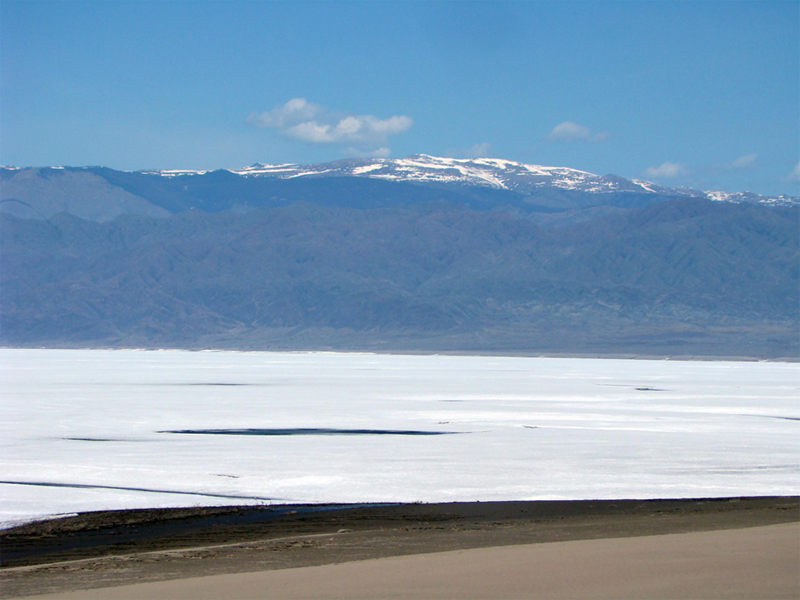
The Sajan Reservoir shore at the beginning
of the excavations in 2009
The archaeological investigations of Terezin cemetery, formerly called “Barchany”, were continued in spring 2009 at the Sajano-Šušenskoe-Reservoir in Tuva, Russian Federation. The excavation campaign was made possible thanks to the financial support of the Society for the Exploration of EurAsia.
Several partly ruined stone
cysts with remains of the burials and artifacts were discovered. Also
a single not disturbed burial was found (No.9). All artifacts were
restored. Two AMS-dates from samples from the graves were received.
|
|
||
The grave No.12 was found at the shore line of the Sajan Reservoir. It was discovered as a cluster of flat stones covered by sand because the cyst fell down from the slope 5 years ago approximately.
|
|
||
The fragments of the human skeleton were found among those stones including the lower jaw with teeth. Several belt buckles made out of bronze were preserved here, including the big open-work buckle with the image of two tigers and a dragon fighting, five smaller open-work buckles and three rings. Also the fragment of a bronze mirror was found here. It is of the same type as the mirror of the Han’ dynasty period which was found at the shore in previous years, but it’s “just” a casting copy of such an object, made by local craftsmen. Besides, three pieces of a ceramic vessel and a bronze model of a kauri shell were discovered in this complex.
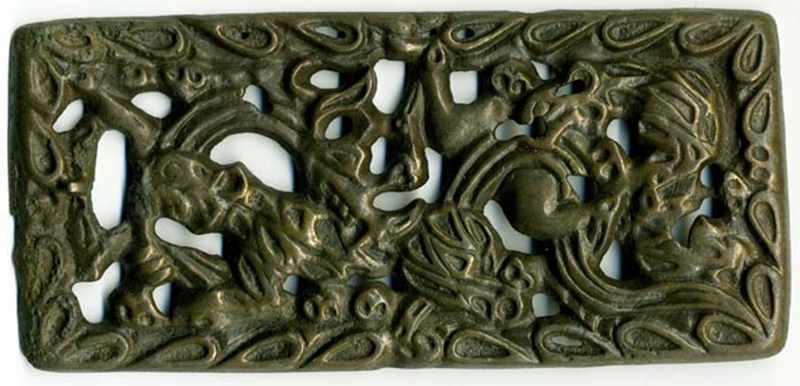
The open-work belt buckle with scene
of the fighting among two tigers and dragon
The grave No.9 was discovered at the slope edge.
The young woman was buried in a stone cyst. The dead person was placed
on her back with bended legs oriented to NNE.
|
|
||
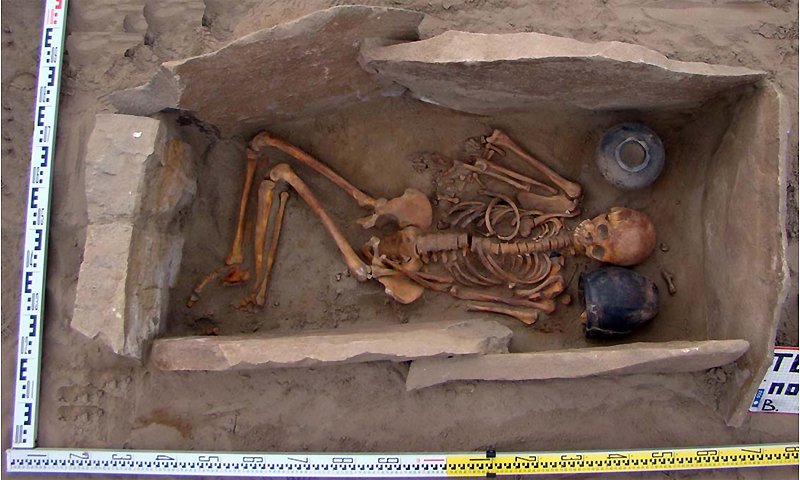
The grave No.9 - view after cleaning off the skeleton
One hand-made and one wheel-made ceramic vessel were found at both sides of the skull. The strongly corroded remains of an iron tool (probably a knife) were discovered by the deceased’s waist.
|
|
||
The glass pendant has analogues from the Northern Black sea region
 and
originated from there probably.
and
originated from there probably. |
|
||
The samples (human teeth) from the graves No. 9 and 12 were dated by the AMS-method. The dates are 1st century BC, the same as for the grave No.2 excavated in the year 2008.
An unique bronze belt buckle was found under the stones from the damaged cyst (grave No.8). It features an image of 6 griffin heads. The stylistic analogues of it are still not known.
There are several exact analogues of the bronze belt buckle with the image of the fighting among two tigers and the dragon. Those buckles were found in situ in the four graves besides several stray finds:
Made of bronze: there are twin buckles from one grave and single one in other grave. All of them were discovered in the Trans-Baikal region


The fragment of the same buckle from the Andrianov’s collection is in State Hermitage in St-Petersburg (Russia)
| - the stray find, probably from Southern Siberia or Mongolia. Also two bronze buckles are in the USA. The origin of the is not known exactly but most probable is Mongolia (Bunker 1997, 274-275, No.242; Bunker 2002, No.105). |
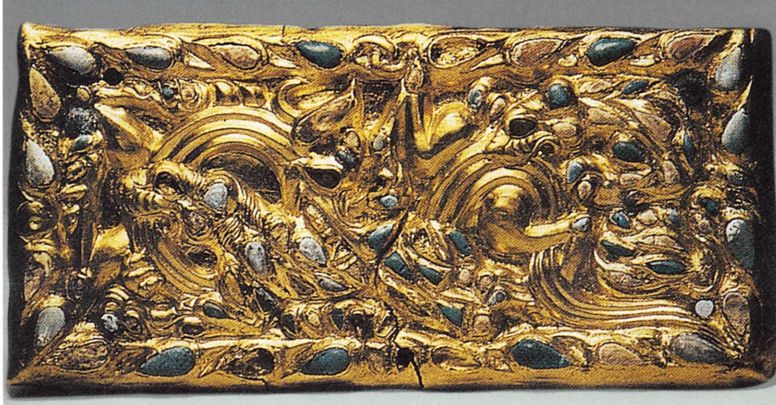
The golden buckle from the Sidorovka cemetery
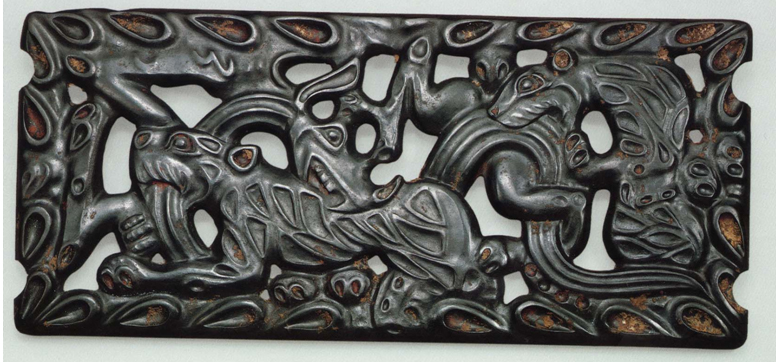
The nephrite buckle from the Hotung’s collection
Made of gold: two massive casting but not open-worked buckles with incrustations from the turquoise, corals and amber were found in burial mound No.1 in the grave No.2 in Sidorovka cemetery in Omsk administrative district
Made of nephrite: the open-work buckle made of dark grey-green nephrite is kept in the Joseph Hotung collection in Great Britain. It’s exact origin is not known but this mineral type of nephrite is mined only in Northern Mongolia, west of the Hangai Mountains (Rawson 1995, 311-312, No.23:1; Bunker 2002, 134, No.106).
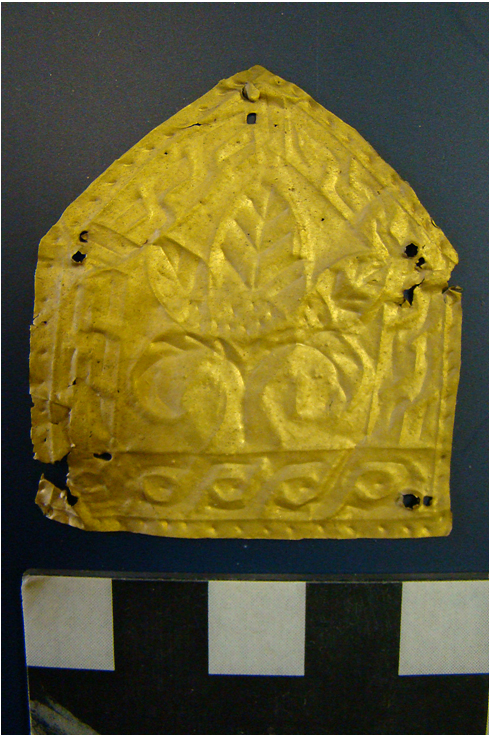
In addition, a golden fitting probably from a belt was found in the sand at the Reservoir's shore line. It might date from the Middle Ages, most probably from the Mongolian period. A bronze belt buckle of the same period was found not far from this place in 2008. It's possible to suppose that these artefacts were from a damaged grave of a noble person. They're dated c. from 13th -14th centuries.
Conclusions:
The material culture known from the Terezin cemetery is identical to the Xiongnu culture including such elements like bronze implements, weapons, ceramics. At the same time, the funeral rite is different from both classic Xiongnu and previous Scythian cultures. But it’s nevertheless possible to identify some features of the Scythian funeral rites.
The archaeological investigations of the Terezin cemetery in near future and next laboratory work could answer the question about the origin of these people. One of the most interesting aspect of the next investigations is to analyze the physic anthropology of those populations. Did they belong to an indigenous population of the Scythian age or were they newcomers or a mixed group?
|
|
||
|
|
||

© Pavel Leus
Project leader
28 December 2009
The archaeological investigations
on Terezin cemetery, Tuva, in 2010
Sponsored by the Society for the
Exploration of EurAsia
The archaeological investigations of Terezin cemetery
in Chaa-khol district of the Republic of Tuva, Russia, were continued
in spring 2010.
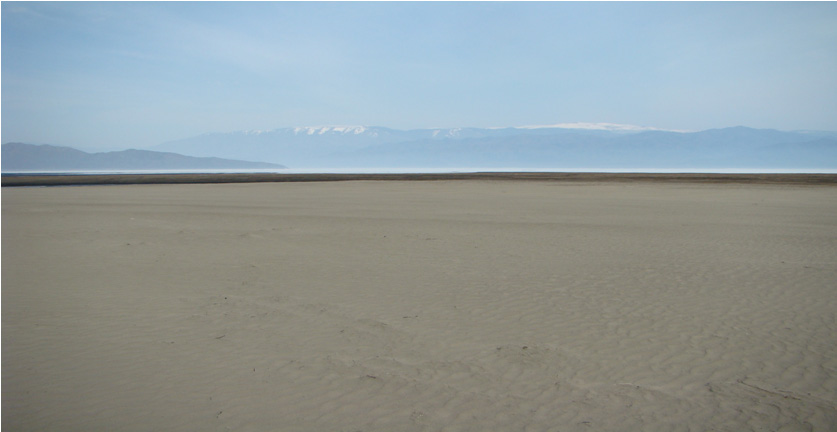
Fig.1 The shore of Sayan Reservoir. View from
Terezin cemetery
The remains of another three cists made of stone were discovered by
the shore. They’ve fallen down from the slope about ten years
ago. They were marked as graves 13- 15. These three cists are located
in the central, richest sector of the graveyard
An open-worked buckle made of bronze was discovered among the flat stones
of the cist No.13. It represents in the style of the Xiongnu two oxen
or two yaks.
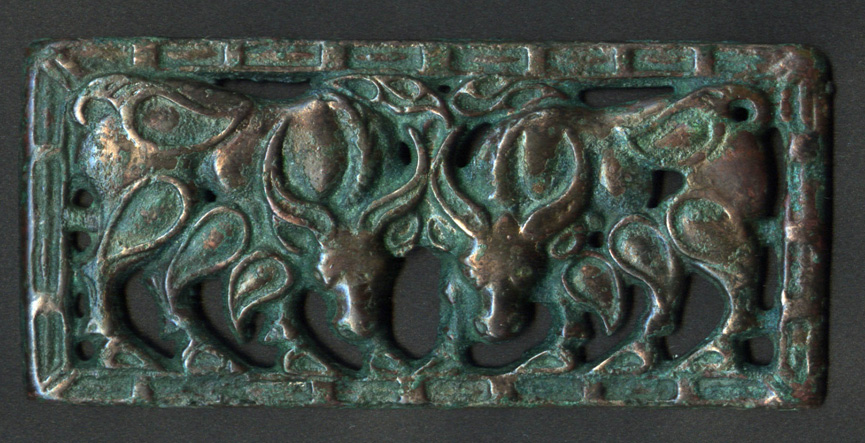
Fig.3 Bronze buckle from grave No.13 featuring two oxen or yaks
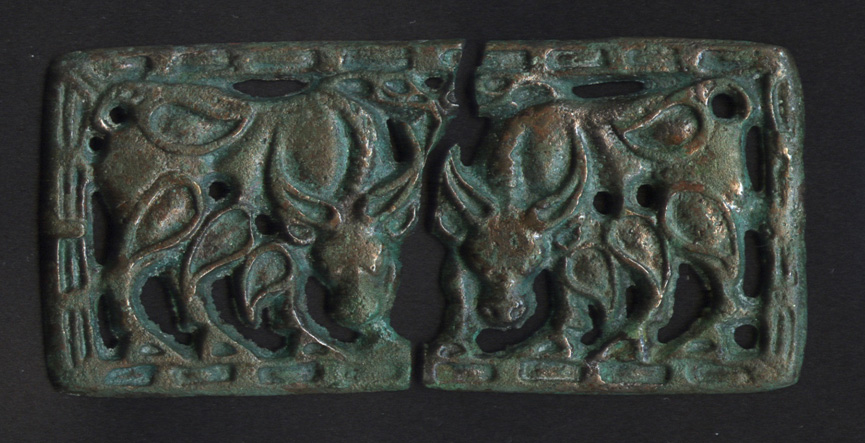
Fig.4 Bronze buckle from grave No.14
Two pieces of a stylistically identical buckle and an open-worked ring made of bronze were discovered among stones of the cist No.14.
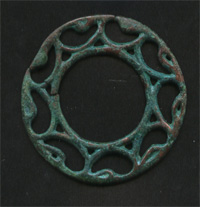 |
||
| Fig.5 open-worked ring from grave No 14, typical for the Xiongnu period |
Various artifacts or bones were found among stones of the cist No. 15.
Parallels to the bronze buckles from graves No. 13 and 14 are known only in the Minusinsk Valley north of the Western Sayan mountains. It’s interesting that the Terezin cemetery is located at the beginning of the Sayan canyon of Enisey which is a most suitable water route to the Minusinsk Valley. Due to this waterway, so many bronze artifacts were discovered in Terezin which have parallels in the area behind the Sayan mountain range. The local population had trade connections with the population of the Minusinsk Valley and controlled this trade route.
What is important, while all such bronze buckles found in the Minusinsk Valley were chance finds, these from Terezin Graveyard are the first discovered in a scientific controlled excavation.
Also several stray finds were found on the Terezin cemetery area which were not directly related to any grave, although they were located near tombs No. 14 and No. 15: a bronze buckle like in grave No. 5, a small bronze buckle with images of oxen (it has parallels with the buckle found here at 2008), open-worked “kettle-like” pendant, as well ceramic fragments of a vessel. All of them have parallels to finds from classical sites of Xiongnu and dates to 1st century B.C.
A Chinese wu zhu coin issued by the Northern Qi Emperor Wen Xuan Di in 553 A.D. was found as well 30 m next to this central graveyard sector. This date corresponds to the time of the Ancient Turks.
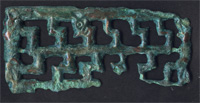 |
||
| Fig.6 bronze buckle | Fig.7 small bronze
buckle with images of oxen |
|
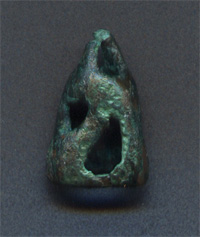 |
||
| Fig. 8 open-worked “kettle-like” pendant | Fig.9 Chinese wu zhou coin from 553 A.D. |
The optimal time to carry out archaeological investigations in this area is end of April- beginning of May. This is the period immediately after thawing. At that time the sand is already dry which allows to make archaeological works. At the same time the Reservoir has not been filled yet. Because of this, the fishermen and collectors/looters of artifacts haven’t reached the site yet.
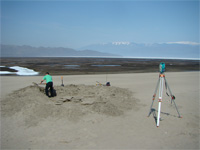 |
||
| Fig.9 Excavation of grave No. 13. |
Local people says that somebody found artifacts here recently several times. But nobody knows where they’re now. Only a ceramic pot found here is kept in school museum in Chaa-Khol village.
Besides the works on the Terezin cemetery, the collapsing cemeteries Sume-Besh 1 and 2 were investigated. They are located on the opposite shore of the Chaa-Khol river. Two washed away burials were discovered at Sume-Besh 1 cemetery. They weren’t visible last year. It means that the collapsing of them happened during summer-autumn of 2009. In total, several dozens of the graves of the early Scythian period are known here. They partly were discovered by the Tuvinian archaeological expedition of IIMK RAS.
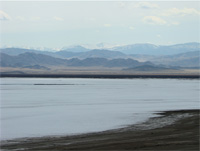 |
||
| Fig.10 View from Sume-Besh to Terezin cemetery | Fig.11 The cist on
Sume-Besh 2 cemetery |
The wooden frame-work of a tomb partly washed out by water was found
on Sume-Besh 2 cemetery. It dates to the early Scythian period 6th century
B.C.. The human bones were visible among wooden structures and stones.
The knife made of bronze was found here as well.
The stone cist partly washed out by water was found a bit downhill.
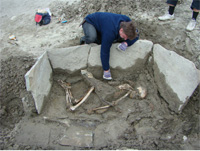 |
It was burial of the young man laying on left side with bended knees. |
|
| Fig.12 Sume-Besh 2 cemetery. Grave 1. |
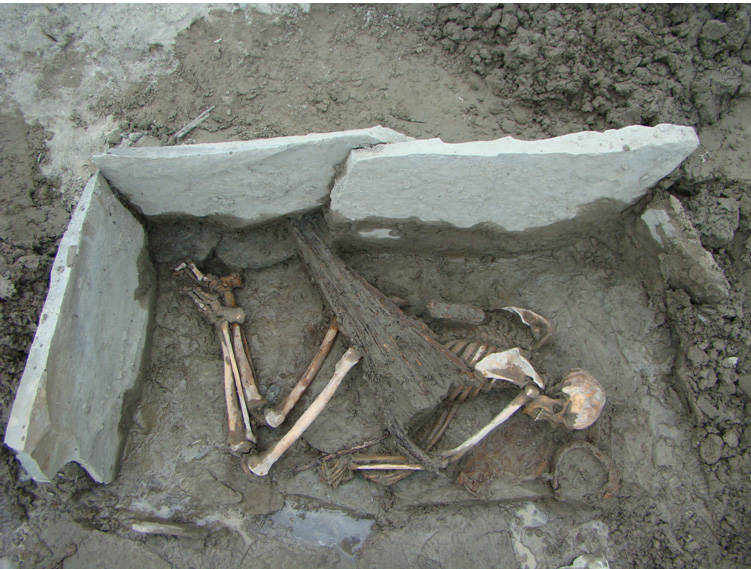
Fig.12 Sume-Besh 2 cemetery. Grave 1. View from East
The head oriented towards North- East. The bow and quiver with arrows was at the belt. Three arrows were made of bronze, two made of wood and one probable made of bone. Unfortunately, the wooden remains were very wet and had poor preservation because of water activity. The wooden dish and scoop were found at the face of the deceased. They were in such poor preservation, that it was impossible to save them. The bronze knife and wooden comb were found by the belt. Both of them were taken out for the restoration. Thus, the collapsing of the archaeological sites by the Reservoir shores is continuing; the objects are washed out every year.
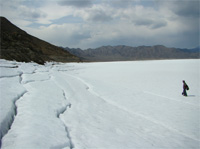 |
||
| Fig.13: Walking on the frozen lake | Fig 15. The beginning of Sayan canyon |
Finally, a place already located in the Enisej-Valley was surveyed by walking over the frozen lake which was an ideal timing (that place would be later in the year either flooded or would emerge as an island, and there would be a risk, that owners of motorboats would follow.) At least 10 Scythian kurgans are already highly damaged by the water, others have disappeared. Some Bronze chance finds were made on the surface of mirrors, buckles, knives, daggers and battle axes. The pieces were handed out to the archaeological authority in Kyzyl, Tuva.
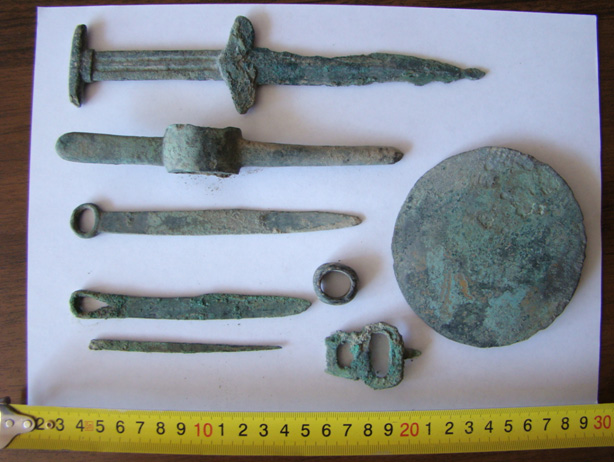
Fig 14: Chance finds at the entry to the Enisej-Valley.
Outlook 2011: It is planned to conduct the geo-magnetic prospection of the major parts of the Terezin necropolis.
Pavel Leus, Berlin, 20. 01. 2011
Collaborator in The Committee for the Cultural and Historical Preservation
of Historical Monuments of the Republic Tuva
The archaeological expedition to the Terezin Cemetery, Tuva, in 2011
From 27 April till 5 May 2011 a geomagnetic survey was conducted at the site of the Hunnish Terezin Cemetery, situated at the southern shore of the Sayano-Shushenskaya dam lake. The survey was conducted by A.V. Chudin from the St. Petersburg State University, Faculty of Physics, Department of Quantum Magnetic Phenomena.
The objective was to determine borders and structures of the total burial site of Terezin by finding in situ graves (stone chests), stemming most probably from the Hunnish period. The ca. 1 km long graveyard is covered by sand. 7 places amounting to a total surface of 1 hectare were explored.
Unfortunately the whole magnetic search failed to reveal any significant anomaly in the surveyed terrain, no further tomb was found. As a hypothesis, the chosen method of this magnetic survey was not appropriate to the specific properties of the terrain.
For further information, please refer to the full report (PDF).
East of Terezin a few above-the-ground stone chests and 4 already flushed-out kurgans from the Kyrgyz period (9th-10th century CE) were found. The geographical coordinates were given to archaeologists from St. Petersburg who conducted there in summer a rescue excavation and found in and next to one of these 4 kurgans numerous arrow heads, bronze and silver belt plates and pieces of horse-gear. The owner of this tomb was probably a wealthy warrior. Finally a single, large medieval iron cauldron was found in the dunes.
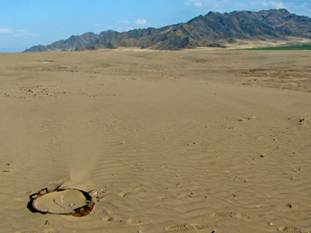 |
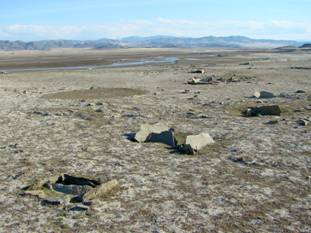 |
| A medieval iron cauldron in situ | Flushed-out stone chests |
Conclusion
We will further analyze the report from the magnetic survey in order to understand why it failed to identify any significant anomaly in the searched terrain. In view of the rich accidental previous finds and discoveries, it seems unlikely that the graveyard of Terezin would be already empty and all tombs would have been identified. In this process we will consult external experts in the field of geomagnetic prospection before reaching a conclusion how to further proceed.
Publication
In 2011 Pavel Leus published a comprehensive and illustrated report entitled “New Finds from the Xiongnu Period in Central Tuva. Preliminary Communication” in Volume 5 of the “Bonn Contributions to Asian Archaeolgy”, edited by Ursula Brosseder and Bryan K. Miller.
Please refer to the PDFs of the contribution as well as of the preface to the volume and its complete Bibliography here below:
Xiongnu_References_Glossary_Authors (PDF)
Xiongnu_Contents_Foreword_Preface (PDF)
Leus Xiongnu in Tuva (PDF)
Christoph Baumer, 29. 03. 2012
Validation of the geomagnetic survey and completion of the project
Following the negative results from the geomagnetic survey conducted by the St. Petersburg State University, Faculty of Physics, Department of Quantum Magnetic Phenomena, all data were re-analyzed in 2012 by the Bavarian Archaeological Survey, Section of Geophysics, Munich. This second analysis confirmed the overall negative results and came to the conclusion that the specific mineral composition of the sand dunes stretched over the graveyard of Terezin would not allow for better results, irrespective of the chosen methodology. Therefore the Bavarian Archaeological Survey couldn’t recommend conducting a second survey using another technology.
In view of the huge size of the necropolis where the visible above-the-ground tombs have been investigated by the Society’s previous expeditions and that excavations without visible guidance are not feasible, it has been decided to close the project. In two to three years the site will be re-checked, in the meantime a final report is due to be established.
C. Baumer
Ala-Tey: New archaeological findings from the Xiongnu period in Tuva, 2015
Pavel Leus, BerlinIn late May and early June 2015, a group of the TAE , St. Petersburg, performed an archaeological field survey at the Sayano-Schuschensker Reservoir in Central Tuva (Russia). Archaeological objects were prospected far from the shore line, which remain below the water surface of the reservoir for almost the entire year. Flooded from around the end of June to early July, the area is only free of ice, snow, and condensation again in mid- to late May.
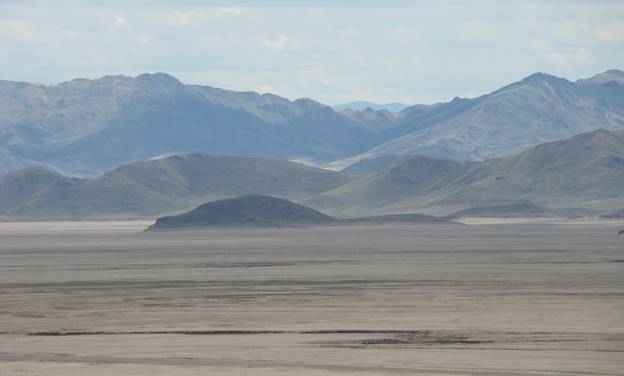
Fig.1 Reservoir bed in the research area.
During the field survey of the isolated mountain Ala-Tey (translated from Tuvian as "Colorful Mountain"), portions of the burial sites (so-called stone boxes) were found to be partially exposed. They recalled the stone boxes of Xiongnu period that were discovered a few years ago at the Terezin burial ground about 4.5 km away.
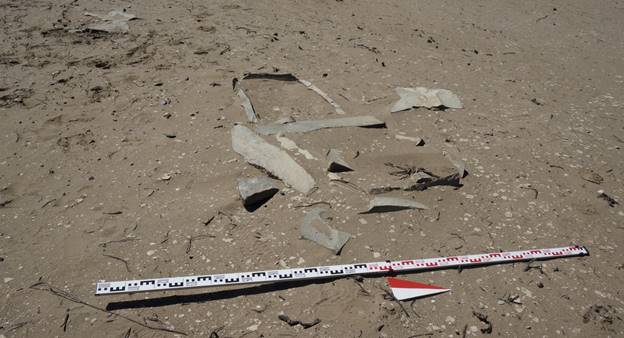
Fig.2 One of the exposed stone boxes.
This area is usually flooded again with the water of the reservoir around late June to early July. The burial sites are then 20 meters below the water level.
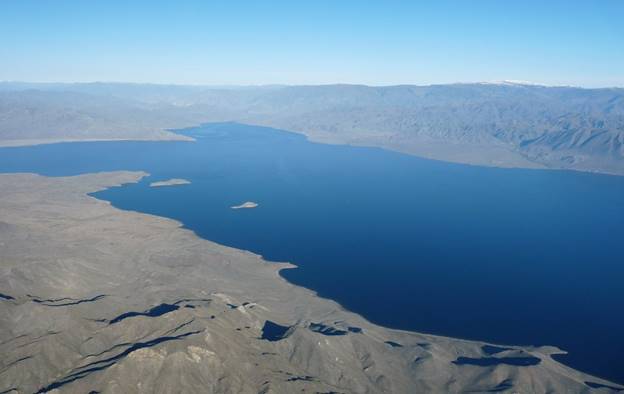
Fig.3 When the reservoir is filled up, the research area is beneath the water.
A total of 15 graves were exposed, which – extraordinarily – proved to be fully intact. Thanks to the archaeological findings, it is possible to provisionally date them all to the Xiongnu period (approx. 1st century BC.). A more precise estimate, however, will not be possible until the planned AMS dating.
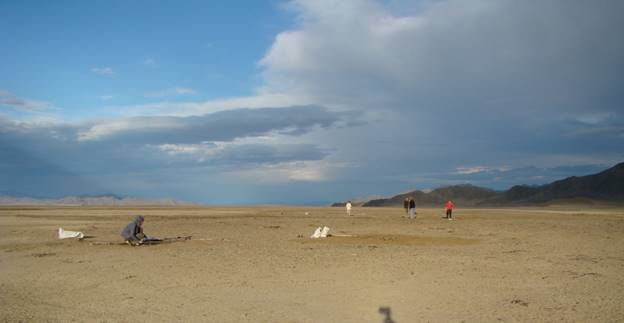
Fig.4 Excavations at Ala-tey
Three AMS dates have already been obtained for the Terezin graves, which clearly date the grave sites there to 1st century BC. As the two burial grounds show many parallels in the burial rites and the archaeological findings, we suspect a similar dating for the graves of Ala-Tey.
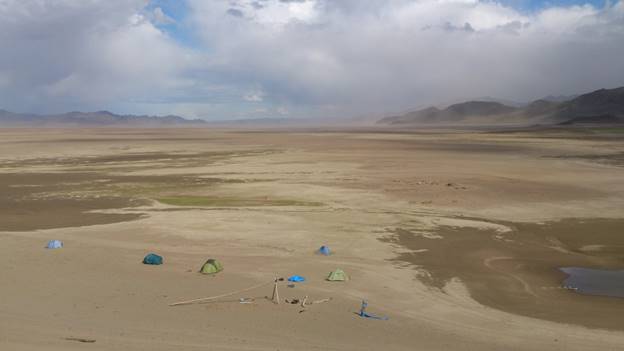
Fig.5 Expedition camp on the reservoir bed
The Ala-Tey burial ground forms a compactly situated group of juxtaposed flat graves with different grave constructions and placements of the dead. There are graves in stone boxes made of stone slabs, where the dead were laid in a stretched supine position or with bent legs. Furthermore, there are graves in wooden coffins made of boards (?), with and without a stone framework. Most stone boxes could already be seen from above, as they were constructed in barely sunken sand pits. As a result, some cover slabs were exposed.
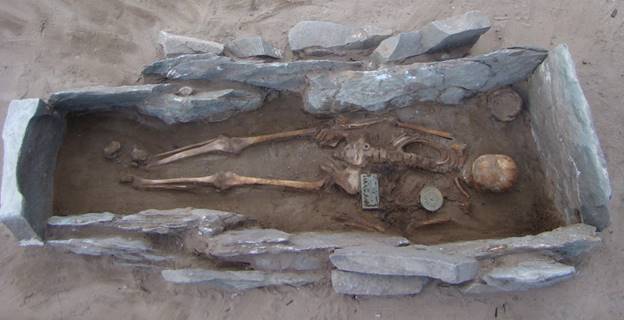
Fig.6 An exposed grave in a stone box. Ala-Tey
The archaeological findings from Ala-Tey have parallels to other Xiongnu-period burial grounds, not only in the nearby Terezin burial ground, but also in Transbaikalian, the Minussinsk Depression, northern China and Mongolia.
In Grave 11 from Ala-Tey, for example, there are beautiful openwork bronze plates and rings from a belt set, a large openwork belt buckle showing two yaks, and a bronze mirror, which resembles some Chinese mirrors from the Han Dynasty (including the mirrors of Terezin).
In Grave 12 from Ala-Tey, besides the openwork bronzes, the belt plates of argillaceous shale were also found, and, in between them, a very rare artifact inlaid with coral and turquoise beads (?). Such argillaceous shale plates are known from the trans-Baikalian burial grounds of the Xiongnu period, e.g. from the burial ground of Ivolga.
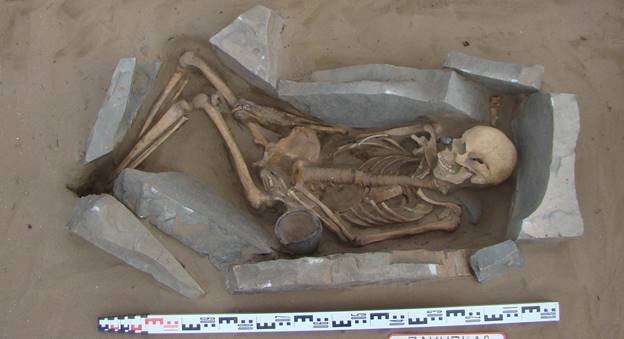
Fig.7 An exposed grave in a stone box. Ala-Tey
In comparison to Terezin, it is interesting to note that only handmade ceramics have been encountered so far at Ala-Tey, not those made on the rapidly rotating wheel.
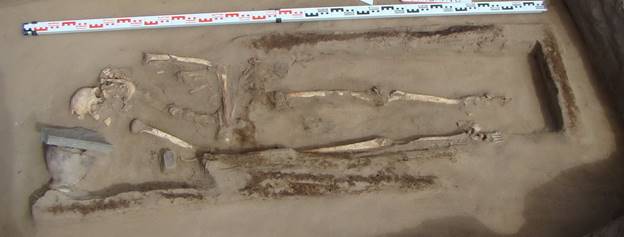
Fig.8 An exposed grave in a wooden coffin. Ala-Tey.
From an anthropological perspective, the people buried at Ala-Tey also seem to be different. This, however, can only be clarified after the intended in-depth anthropological examination. It is possible that not only the immigrant Xiongnu were buried there, but also the local post-Scythian population.
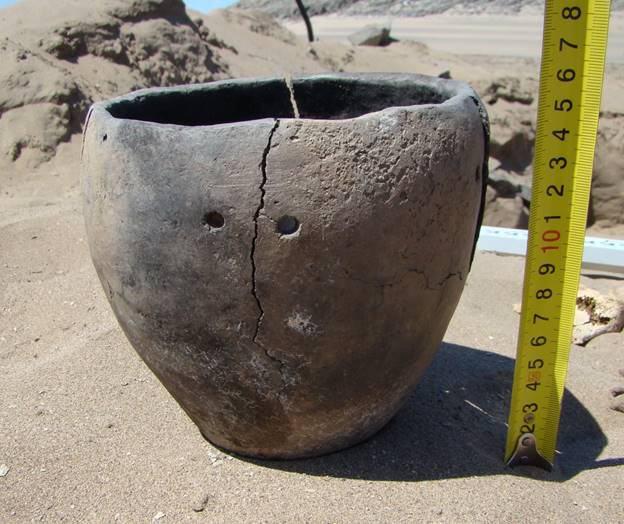
Fig.9 A handmade pot with repair site. Ala-Tey.
Next year, the field research will continue at the Ala-Tey burial ground.
A brief survey was also carried out this year at the Terezin burial ground. In some places, the recent extensive deterioration to the shoreline was discovered. Along with some human bones, a fragment of the ornamental bronze mirror was found on the shore. Another extensive exploration of the area has been planned for the coming year.
July 6, 2015
New excavations of the Xiongnu's epoch burial ground Ala-Tey in Tuva in 2016
(download here)
Pavel Leus
With the support of the "Society for the Exploration of EurAsia” an unknown burial ground from the Xiongnu period, named Terezin, was discovered in Central Tuva in 2007. This archaeological site was about to collapse due to the natural erosion provoked by the Sayan-Shushenskoe hydrostation reservoir and its annual rising water level. During its research we have manage to identify and locate 15 burials, including several intact ones. In the burials and around the already destroyed stone constructions, rich funeral inventory was discovered, including typically Xiongnu weaponry and bronze details of belts, items imported from China – a fragment of Han' bronze mirror for example. Large openwork bronze belt buckles belong to the most interesting findings because of parallels among Xiongnu period sites of the neighboring areas: the Minusinsk Basin, Transbaikalia, Mongolia, Ordos and others. (Fig. 1)
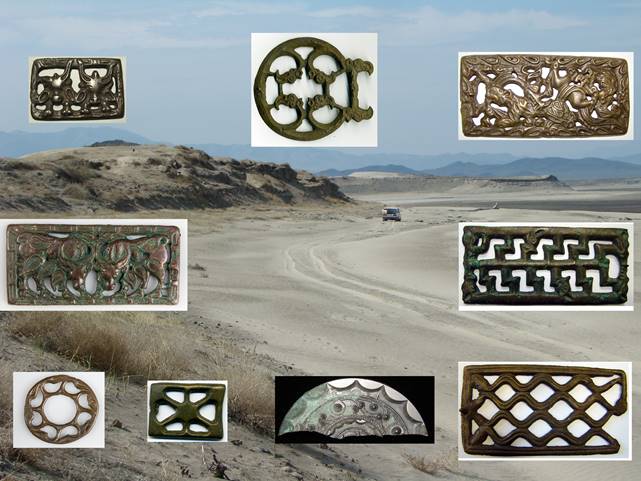
Fig 1. Xiongnu’s period cemetery of Terezin and some excavated artefacts
Such buckles were so far unknown in Tuva, except one from the Urbiun cemetery at the confluence of Chaa-Hol' river and Yenisei, only 6 kilometers away from Terezin burial ground.
In that area there is also another burial ground called Aimyrlyg located 10 kilometers upstream the Chaa-Hol' river. About 200 burials were excavated by E.Stambulnik in the 1970-80s , some belong to the Xiongnu period (up to now the excavations data has not been published, precise dating of most of the burials is impossible). About 40 kilometers up the Yenisei river valley, near the town of Shagonar, big mounds of the Xiongnu's nobles were discovered and excavated by A.Mandelshtam in 1965-66 and 1976-77, resembling the burials of Noin-Ula in Mongolia. Unfortunately those in Tuva were heavily looted.
Overall, there are several sites of the Xiongnu period in this part of Ulug-Khem basin besides Terezin, but most of them were looted in the past, or the funeral inventory was rather poor. Dating of those sites also remained relative. This part of Ulug-Khem basin at the entrance to Sayan canyon is strategically an important area: here begins the way across the Sayan ridge to the Minusinsk Basin; moreover the largest and best pastures in Central Tuva were situated here. This is also the reason why numerous archeological sites, which belong to the Bronze Age, times of Scythians, Xiongnu and ancient Turks (settlements, fortresses and burial grounds), are all concentrated in this part of the valley. (Fig. 2)
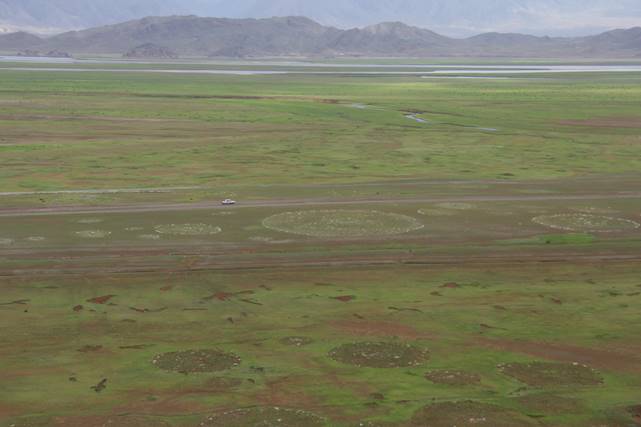
Fig. 2 Part of the Scythian’s time cemetery on the reservoir floor, before flooding
At the beginning of the 20th century Chaa-Hol' village was the most important trade center in Tuva, later this settlement had been moved to another place because of the flooding zone. Control of this area was an important task during all historical periods, so a detection of the Xiongnu period sites, was not a surprise. The main problem is however that the central part of this territory is covered with water of the Sayan-Shushenskoe hydrostation reservoir. (Figs. 3, 4).
The difficulty of finding flat graves in the flooding zone is that time for archeological work is here very limited. Snow melts at the end of April-beginning of May, and only when the smelting water left it is possible to start working. By the middle of June the water of reservoir raises and the main area of investigation is flooded again and inaccessible for researchers until the following year.
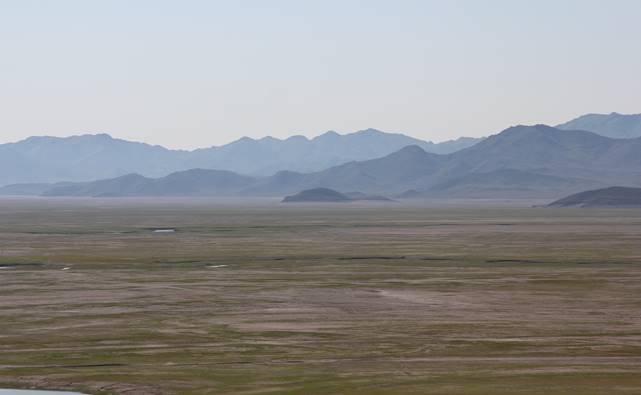
Fig. 3 The reservoir floor at the beginning of June
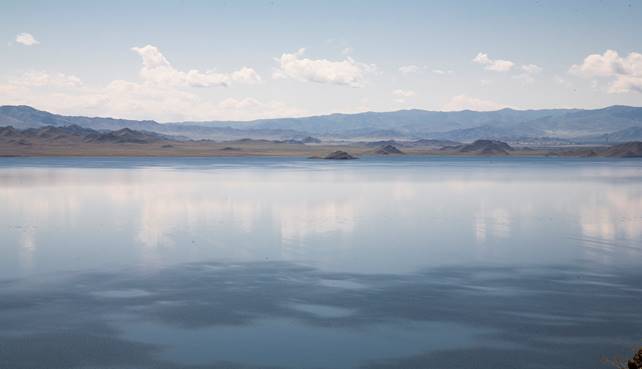
Fig. 4 The reservoir at the beginning of July, after flooding
In 2014 our expedition managed to find another untouched burial ground of the Xiongnu period – called by the name of the nearest cliff: Ala-Tey. This cemetery is situated 4,5 kilometers from Terezin, on the flooded part of the steppe where excavations are only possible 3-4 weeks within one year. When full, the surface of the Sayano-Shushenskoe reservoir is 540 meters above mean sea level, while the Ala-Tey cemetery lies at 523 m AMSL, hence it lies almost 20 meters below the water surface.
During the 2015 expedition objects 1-15 were excavated (s. report 2015). The upper layer of soil was washed away by the reservoir as well as the upper stones of a few funeral stone boxes. To date there are 33 objects excavated here, mostly containing untouched burials of Xiongnu. (Fig. 5)
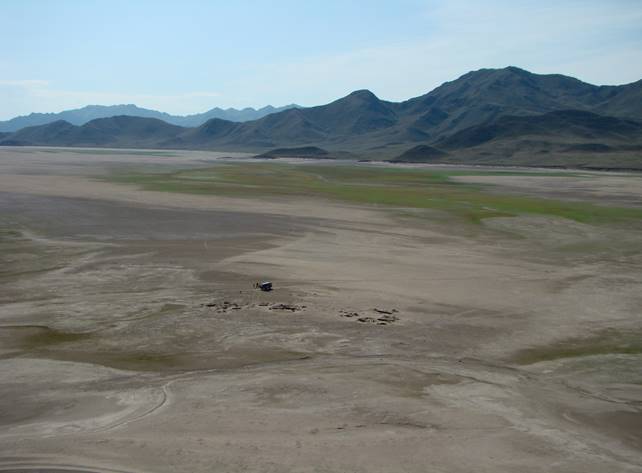
Fig. 5 Excavation of the Ala-Tey cemetery, before flooding
The excavations at the Ala-Tey cemetery were continued in 2016. The expedition lasted from 03 June to 18 June 2016. In this year, the Sayano-Shushenskoe reservoir filled up with water somewhat earlier, so that by 17 June the water had already come quite close the excavation site.
Objects 16-33 were discovered and exposed during the excavation. Objects 17-33 are flat graves, Object 16 is not a grave, merely a pair of small stone panels lying in a shaft.
The deceased had been deposited in the excavated graves in supine extended position. Double burials were found in four of the graves: 2x2 adults, 1x 2 children (a stone cist atop the other in a burial pit), 1x mother and child.
There are several types of burial constructions – stone boxes – (Figs. 6-7), often built in two levels (like in the burial # 9 from Terezin), burials in narrow pits (where the contours of burial pits are impossible to track as since the end of the 1980s this sandy landscape is at the bottom of the water reservoir most time of the year), overlaid with stones or stone tiles. Those constructions are usually rectangular (in one case – boat-shaped – (Fig.8), sometimes we could notice remains of a wooden frame inside (maybe a coffin, but due to the regular water erosion, the condition of the wood is either extremely bad or there are no remains at all).
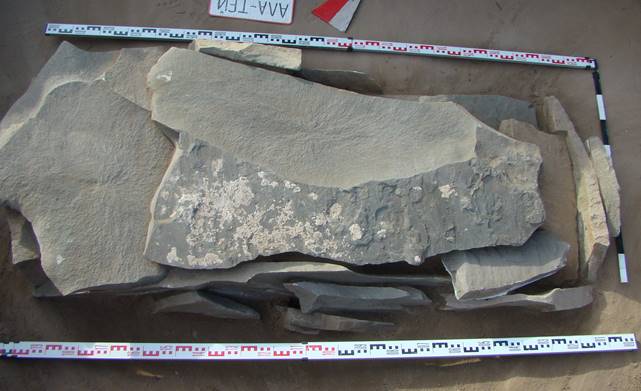
Fig. 6 Cist grave
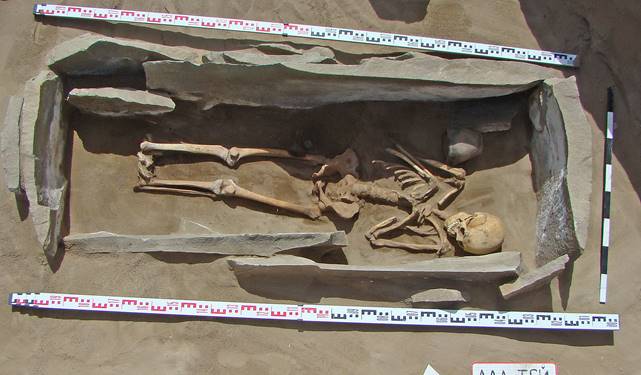
Fig. 7 Cist grave
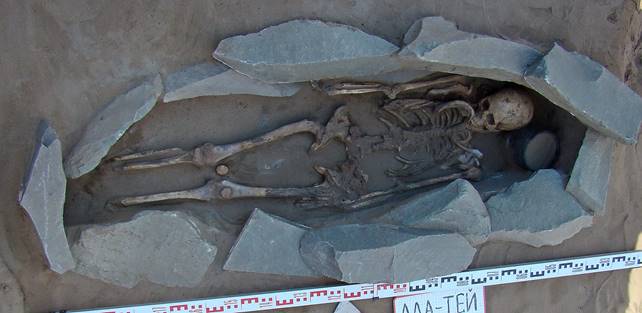
Fig. 8 „Boat-shaped” stone burial construction
There are also graves without any burial constructions – (Fig. 9), which could have been wooden and did not survive.
Most of the skeletons lay in supine position like in the burials of Xiongnu in Transbaikalia and Mongolia, also in the burials of the Tes’ culture of Minusinsk Basin. In few instances the deceased was buried on the back with the legs bent. There were pot-shaped molded vessels standing in all the burials beyond the deceased’s head. No weaponry was recovered, but several belt and cloths’ decorations, necklaces, pendants and earrings, local copies and imports of Chinese mirrors and fragments were excavated.
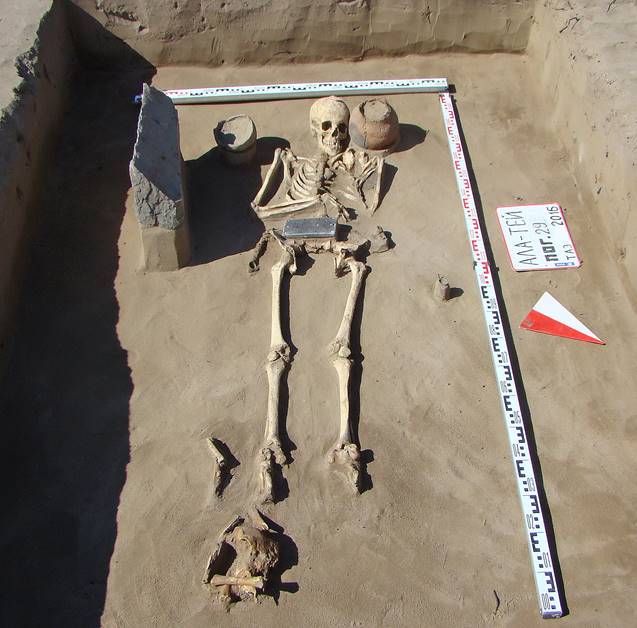
Fig. 9 Grave without burial construction, with a stone belt buckle with insets of coral, turquoise and mother of pearl.
There was also an intact bronze mirror in one of the burials with an inscription in Chinese: “When I look at the sky, I always think about the ruler” (Fig. 10). A similar mirror is kept in the Minusinsk museum. In two of the burials, belts were found, decorated with bronze models of cowrie’s shells and wu zhu coins – (Fig. 11), which provide a terminus post quem – 118 B.C. – the first year when such coins appeared into circulation in China.
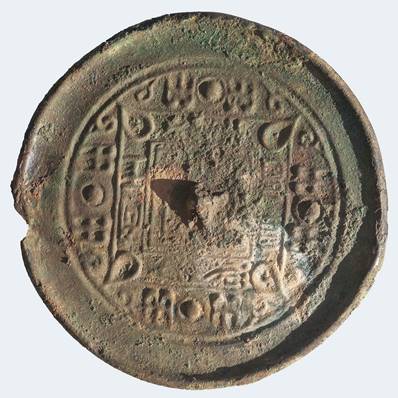
Fig. 10 Chinese bronze mirror with inscription
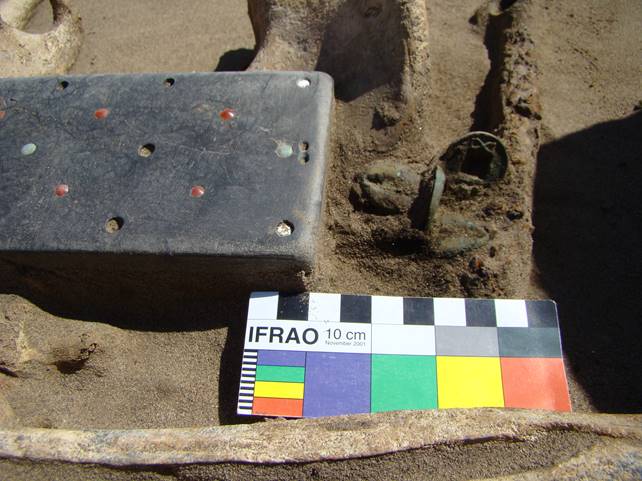
Fig. 11 Chinese Wu Zhu coins, bronze models of cowries shells and buckle with insets of coral, turquoise and mother of pearl.
Openwork bronze belt buckles made of different types, found in the Terezin and Ala-Tey cemeteries, present themselves as masterpieces of the metal art casting and attract a great interest. Firstly we should mention large plaques with the image of two yaks walking towards each other (for now we have found 4 such buckles – 2 in Terezin, 2 in Ala-Tey) – (Fig. 12). Their massive bodies are decorated with drop-shaped patterns, representing fur and four legs with hooves. The heads are depicted en face with horns, nostrils and “bulging” eyes. Notched relief on the back shows the mane. The frame of the buckles is designed with set-in rectangles, as well as drop-shaped ones for colored insets. Such large belt plaques with the image of two opposing bulls or yaks are known, mostly on the territory of the Minusinsk Basin, where several intact buckles and their fragments were found (totally 19 examples), in the main those are casual findings. Another such buckle, likely comes from Inner Mongolia, and a pair of buckles from the burial ground of Early Han' dynasty on the north-east of Liaoning Province in Manchuria. We obtained an absolute date for one of the burials with such buckle on Ala-Tey – 2092 +\- 27 BP.
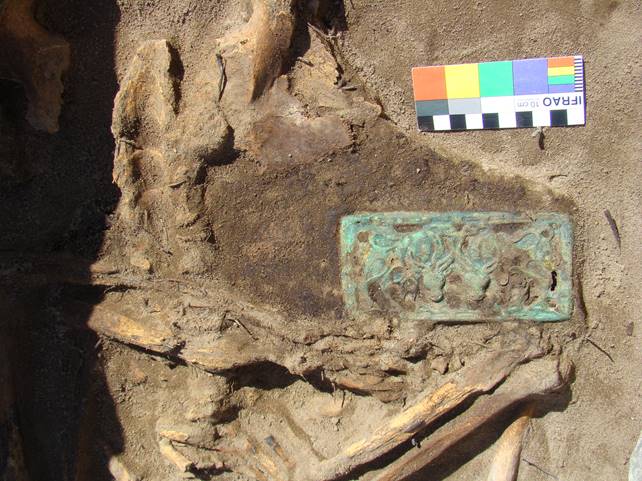
Fig. 12 Openwork bronze belt buckle with two yaks
A unique large buckle with an en face depiction of a bull was found on Ala-Tey – (Fig. 13). Ears and horns are shown with drop-shaped patterns, the muzzle is long with opened mouth, “bulging” eyes, the body seem shortened and stretched also en face. It is difficult to grasp the pattern design because all surface of buckle is covered with leaf and drop-shaped indentations.
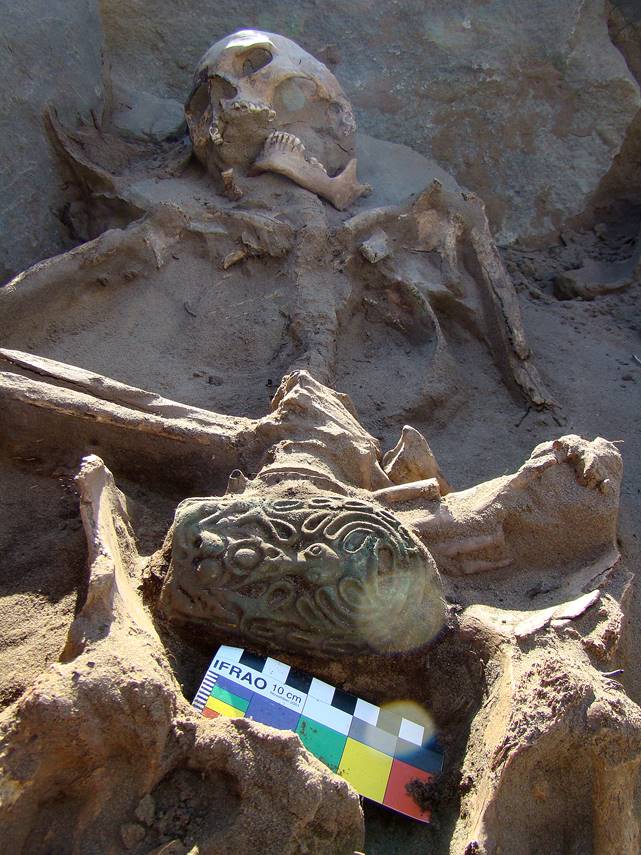
Fig. 13 Large belt buckle with depiction of a bull or yak
A belt buckle with the image of two Bactrian camels was found in one of the Ala-Tey burials – (Fig. 14). Although buckles with camels have been found in the monuments of Mongolia and the Ordos, we have found no direct analogies for this buckle from Ala-Tey.
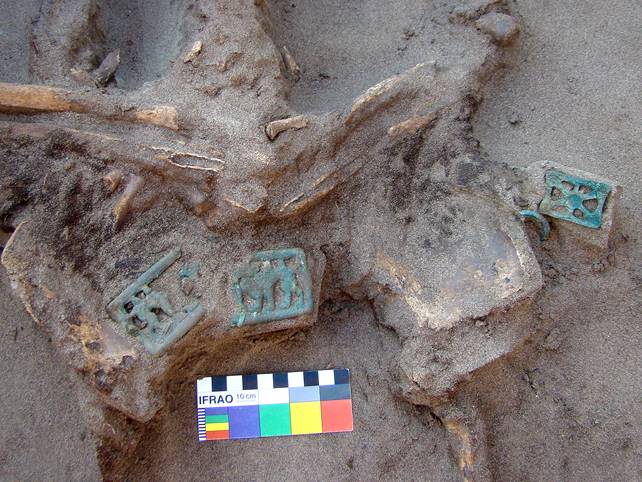
Fig. 14 Belt buckle with two Bactrian camels
Because all the burials in Ala-Tey were intact, we were able to identify the construction of belts, which were an important part of the ancient nomad's dress. A series of belt plaques made of shale and decorated with color insets is quite interesting. There are small plaques, which probably served as analogy to the small bronze belt plaques and large ones – analogies of large belt buckles. We found also a stone plaque that is drilled so it could be attached to the belt. This big buckle from Ala-Tey has the impressive size 19x9 cm, and is decorated with insets of coral, turquoise and mother of pearl – (Figs 9, 11). Undoubtedly a prestige item, which belonged to a man of high social status. Such plaques are well known from Transbaikalia but in most cases they are damaged and the color insets are lost.
It is notable that the women’s graves have relatively rich grave goods (e.g. bronze mirror, earrings made of gold and bronze, openwork belt plaques, Wu-Zhu coins, etc.) By contrast, grave goods in the men’s graves are fairly scanty, aside from ceramic pots they only occasionally feature smaller objects made of iron.
There are no items executed in Scythia-Siberian animal style in the burials of Xiongnu in Tuva, since in the late Scythian burials there are no such stone belt buckles with fishnet pattern. We meet only single items, which could be referred to Xiongnu. Although some of these monuments coexist, because some late Scythian burials could be dated to the 1st century B.C. At the same time, Scythian funeral rites with placement of bodies with the legs bent into stone boxes exist on the burial grounds connected with the Xiongnu, like in Terezin or Ala-Tey.
Presumably, these people in Central Tuva who settled in a key location at the entrance of the Yenisei River to the Sayan canyon, had close contacts with the Xiongnu of Mongolia and Transbaikalia and also with the Tes’ culture of the Minusinsk Basin. Along with them, the last bearers of the late Scythian culture existed here. We think that with the expansion of the Xiongnu Empire an assimilation of the Scythian culture took place and as a result of a merging process, both cultures disappeared, or transformed into the Kokel’ culture.
19 March 2017
Excavations
of the Cemeteries of Ala-Tey and Terezin in Tuva in 2017
In 2017 the Tuvan Archaeological Expedition of IHMC
RAS (St.Petersburg, Russia) continued the excavations at the cemetery of
Ala-Tey.

Fig.1 Excavation of the cemetery of Ala-Tey in 2017
The excavation was scheduled to take place over the
course of one month, from the 20th of May to the 20th of June, when the
meltwater had already drained away and the filling of the Sayano-Shushenskoye
Reservoir had not yet started. For technical reasons the filling of the
reservoir was delayed for two weeks this year so it was decided to continue the
excavations until the reservoir was filled, which occurred on the 3rd of July.

Fig.2 The cemetery of Ala-Tey during flooding
The area excavations included the objects excavated in
the previous years to make sure no blind-spots were left within the territory
of the cemetery. The majority of the objects previously excavated were located
at shallow depths or even on the surface, so the contours of the grave pits
were untraceable. The regular submersion of the cemetery has resulted in
mixture of the upper layer of sand which also makes tracing the contours
impossible there. In 2017 we started the excavation of the graves located at a
depth of 1 – 1.5 meters, sometimes 2 meters. In many cases it became possible to
trace the contours of the grave pits.

Fig.3 The contours of the grave pits
During the 2017 excavations, 53 new
objects were discovered. Thus the total number of objects found at the cemetery
of Ala-Tey increased to 86. Most of the objects were excavated; a few were conserved for
next year’s excavations.

Fig.4 Excavated
graves at Ala-Tey
The excavation area tends to expand,
and the discovery of new objects is expected next year. All the Ala-Tey finds are currently kept in IHMC RAS (St.
Petersburg) for scientific research and restoration. Subsequently they will be
sent to the National Museum of the Republic of Tuva.
All of the graves excavated this year
belong to the Xiongnu period and date to the 2nd-1st centuries BC.

Fig.5
Burial in wooden coffin with stone siding
The graves revealed several types of burial rituals.
Most of the burials are made in large rectangular or occasionally boat-shaped
stone boxes or in wooden coffins or frames with stone siding. There are also
burials without any grave structure. The orientation of the deceased varies;
most are oriented south-west and north-west. The burials are generally
individual, rarely paired.

Fig.6
Individual burials
Most of the dead were interred in an
extended supine position, in some cases lying on one side with the legs flexed.
Men’s arms are usually laid by their sides; women have their arms crossed over
the pelvis or chest, some have the left arm flexed with the hand towards the
left shoulder.

Fig.7 Burial with
bronze belt buckle and Chinese mirror
The most interesting and rich grave
goods were deposited in women's graves. What captures the attention first is
the central element of the belt set: large belt buckles depicting animals, e.
g. bulls, camels, horses, and snakes. Most often these are openwork buckles
depicting a pair of yaks or bulls; 5 such pieces have been found to date at
the cemetery of Ala-Tey (plus two pieces at the cemetery of Terezin). In some
cases the wooden base to which the buckle was attached has also been preserved.
In women’s burials we found bronze
mirrors, both entire and in fragments. Most of them are original Chinese
mirrors of the Western Han period (2nd - 1st centuries B.C.) or local copies of
such mirrors, some with a Chinese hieroglyphic inscription “When I look at the sky, I always think about the ruler”.
Fragments of two earlier Chinese mirrors belonging to the preceding period of
Warring States - a mirror with T-shaped symbols and a mirror with a pattern of
zigzag rhombi and spirals - were found last year. As yet no mirror of the
Eastern Han period (1st - 2nd centuries B.C.) has been
discovered here.

Fig.8 Burial with stone belt buckle
Another big stone buckle decorated with turquoise, coral and probably amber inlays was found. The most striking discovery is a stone buckle engraved with animal figures. These are depictions of a mountain goat hunting scene and a horse with a twisted croup. The images of animals with twisted bodies are typical of the Pazyryk culture of the Scythian epoch and also appear in the tatoos of the famous Pazyryk mummies.

Fig.9 Stone Belt Buckle with inlays

Fig.10
Engraved Stone Belt Buckle
In some women’s graves there were beads of different
types and materials and earrings of golden and bronze wire.
In men’s burials we found mainly iron artifacts - belt
buckles and shoe buckles, knives, iron rings and hooks.
In two burials two bone plates from composite bows of the Xiongnu type were
found. No other weapon has been discovered to date. Bronze spoon-shaped
strap-ends decorated with zoomorphic or geometric patterns should be considered
part of the men’s belt set.
In two burials (one woman’s and one man’s) horse
skulls were found situated near the legs of the interred. One of the skulls
(from the man’s burial) was bridled, the bridle consisted of iron with bronze
details.

Fig.11
Man’s Burial with a horse scull
The cemetery yielded a wide range of
various ceramic vessels. These are mainly jar-shaped pots, but there are
wheel-thrown vases with vertical polishing as well. On the former ground
surface above some of the burials (or on the edge of the grave pits) standing
shallow vessels divided into two compartments with a hole in the middle of the
partition were found.

Fig.12
Pottery from the cemetery of Ala-Tey
Many of the items from the cemetery of Ala-Tey have
analogies at the Xiongnu sites of Trans-Baikal, Mongolia, Northern China, also
in Minusinsk Hollow and Altai.
This year we inspected the bank of the reservoir at
the cemetery of Terezin and discovered a burial of the Xiongnu period, parts of
which had fallen down from the precipice. Among the grave goods there were two
ceramic vessels, one of which was a typical Xiongnu vase. A noticeable layer of
bronze oxides covered the bones of the pelvis, probably from a big belt buckle.
The buckle was absent; it may have been removed by local residents, who had
discovered the burial before we did.

Fig.13
Xiongnu period grave from the cemetery of Terezin
The excavation of the cemetery of
Ala-Tey and the inspection of the Terezin cemetery area in 2017 yielded a vast
amount of new material and showed the necessity for further research at these
locations. It is essential to create a detailed map of the reservoir area using
modern technology and aerial photography. It is necessary to check the archives
in Moscow and Saint-Petersburg to collect data regarding the objects previously
excavated in this area and compare this to the contemporary situation. Further
excavations on a regular basis in the submerging area and on the banks of the
reservoir are required. Every year new burials are exposed and consequently
destroyed due to the impact of the water and hurricanes.
Three research
articles on the Ala-Tey and Terezin finds are to be published at the end of
2017.
Pavel Leus
Independent researcher,
Berlin/St.Petersburg
Selected Bibliography
Pavel Leus (2008)
- Terezin - a new site of Hun-Sarmatian period in Central Tuva. (in Russian)
Pavel Leus (2011) - NEW FINDS FROM THE XIONGNU PERIOD IN CENTRAL TUVA.
(in English)
Pavel Leus, Stanislav Belskiy (2016) - Terezin I – a burial ground of the
Xiongnu time in central Tuva. (in Russian)
Pavel Leus (2017) - Radiocarbon dates from Xiongnu cemeteries of Ala-Tey and
Terezin in Tuva. (in Russian)
Pavel Leus, Dr.Marina Kilunovskaya - The cemetery of Ala-Tey and the Xiongnu
sites in Tuva. (in Russian) - currently in print
Pavel Leus, Dr.Marina Kilunovskaya - The art of the end of the first millennium
B.C. in Tuva. (in Russian) - currently in print
Pavel Leus, Dr.Marina Kilunovskaya -Archaeological Discoveries in Tuva:
Excavations of the Ala-Tey and Terezin Cemeteries of the Xiongnu Period in
2015-2016. (in English) - currently in print
about the stone belt buckles see:
Ursula Brosseder (2011) - Belt Plaques as indicator of East West relations
Boris A. Raev (2017) - Jet buckles from Zhutovsky cemetery. Archaeological
signs of migrations (in Russian)
Excavations at the Ala-Tey 1 and Terezin cemeteries in Tuva in 2018
In 2018 the Tuvan Archaeological Expedition of the Institute of the History of Material Culture, Russian Academy of Sciences, St. Petersburg continued the excavations at the flat graves cemetery of Ala-Tey 1 and resumed the excavation at the cemetery of Terezin, 4.5 km apart from each other.

Fig.1
Excavation at the Ala-Tey 1 cemetery in 2018
The excavation at the Ala-Tey Xiongnu Cemetery started on 13th of May and ended
on 16th of June, 2018, during the period when the meltwater had already drained
away and the filling of the Sayano-Shushenskoye Reservoir had not yet started.

Fig.2
Plan of the Ala-Tey 1 cemetery after excavations 2018

Fig.3 Excavation at the Ala-Tey 1 cemetery in 2018 with Objects 88-93
The area excavations included some surface tombs excavated in the previous
years to make sure no blind-spots were left within the territory of the
cemetery. The regular submersion of the cemetery has resulted in a mixture of
the upper layer of sand, which also makes it impossible to trace the contours
there. In 2018 the excavation allowed us to locate the graves at a depth of 0,5
– 1.5 meters. In most cases it became possible to trace the contours of the
grave pits.
During the 2018 excavations, 13 new burials were discovered on the excavation
area of 528,98 m², in addition to 86
known from the last years. Thus the total number of tombs found at the cemetery
of Ala-Tey 1 has increased to 99. 14 of the burials were excavated in 2018
(discovered in 2017-2018); a few were conserved for next year’s excavations
(like in 2017) – they were too deep and in June already filled with water.

Fig.4 Excavation at the Ala-Tey 1 cemetery in 2018
The excavation area is expanded, and the discovery of new objects is expected
next year. In 14 excavated burials 384 artefacts were found. All the Ala-Tey 1
finds are currently kept in IHMC RAS (St. Petersburg) for scientific research
and restoration.
All of the graves excavated this year belong to the Xiongnu period and date to
the 2nd-1st centuries BC.
Most of the burials are made in large rectangular stone boxes or in wooden
coffins or frames with stone siding. The orientation of the deceased varies;
usually south-west and north-west.

Fig.5 Excavation of the burial of an archer at Ala-Tey (AT1/86)

Fig.6 Arrowheads and parts of the composite bow from the archer’s grave
All burials were interred in an extended supine position. Men’s arms are usually laid by their sides; women have their arms crossed over the pelvis or chest, some have the left arm flexed with the hand towards the left shoulder. Very interesting were the burials of archers – first at Ala-Tey with bone parts of the composite bow and bone arrowheads, and the burial of a girl with a Chinese bell: the first that has been found at Ala-Tey. These bells are well known in Xiongnu graves in Northern China and the Baikal region (Daodunzi and Derestuy cemeteries for example), as well as in Han China.

Fig.7 Burial of the girl with a small Chinese bronze bell, AT1/91
As usual many ceramic vessels have been found: jar-shaped pots, typical Xiongnu wheel-thrown vases with vertical polishing, and above some of the graves shallow vessels (or maybe peculiar oil lamps) with an internal partition, and a round hole at the base.

Fig.8 Xiongnu ceramic vases from Ala-Tey 1
The
excavation at the Terezin Xiongnu Cemetery started on 19th of June and ended on
9th of July.
The Terezin cemetery is located only 4,5 km from Ala-Tey on the sandy, eroded
shore of the reservoir. The destroyed burials and the objects from them were
found here at an area stretching over about 1.5 km. In 2018 began the project
of the large areas excavation here, with the help of volunteers from the Russian
Geographical Society. The excavation area in 2018 was 987,29 m².

Fig.9 Excavation at the Terezin cemetery in 2018
The result was the discovery of 14 intact and destroyed burials both from the Xiongnu period (II-I cen. BC) and the later Kokel’ archaeological culture (dated to probably the 3rd - 4th cen. AD). Of great interest here was the partly mummified female burial T/21. The part of the body below the waist was not covered with sand and had become mummified. Fragments of leather and textiles from the legs were taken by groups and are currently being examined by scientists and conservation specialists in IIMK RAS, St. Petersburg.
Among the grave goods we can mention a large jet buckle with an engraved symbol like an hourglass or Wu symbol like on Chinese Wu Zhu coins, a bronze mirror in a wooden box, and about 1500 small beads – probably a part of the belt decoration.


Fig.10 Terezin, Object T/21



Fig.11 Some finds from Object T/21. Gagat plaque, bronze mirror, ceramics
In the women's burials T/21 and T/27 unique sets of objects were found which characterize the occupation of the deceased during their lifetime. In burial T/21 we found a wooden round box in which was a copy of a Chinese Han mirror made of copper alloy on a leather loop. Initially, the mirror was placed in a round felt cover quilted with tendon threads. Together with it was found a fragment of a solid wooden comb, probably intended for combing fibres, a small leather purse-amulet, a skein of partially split tendon threads, and about two dozen fragments of thin leather. These leather pieces have multiple holes of different diameters and perhaps served as ornamental material.


Fig.12 Parts of wooden box from Object T/21.
In burial T/27 there was a leather handbag sewn with woollen yarns, which is unusual for leather production in this area (usually, in such cases, tendon threads were used). In the process of conservation, it was possible to carefully open the leather bag.


Fig.13 Terezin, Object T/27.
At the top lay a solid wooden comb with sparse teeth, typologically similar to object T/21. Its handle has a rounded shape and traces of use. At the bottom of the bag was a small bag, tightened with a cord of tendon-like thread. Most likely it was used as an amulet. Similarly shaped leather purse-amulets with curls of hair, nails and teeth inside, are found in burials of the Scythian epoch in the Altai territory. Through X-ray analysis it was found out that the leather bags from both graves do not contain any metal products, teeth or cut nails. Further objects contained in the leather bag were a spindle made from the epiphysis of a bone, impaled on a wooden spindle and wrapped with the finest wool. At the top of the bag there was a fragment of a Chinese copper alloy mirror in a felt case and a strongly corroded iron object (knife or awl).




Fig.14 Terezin, Object T/27. Wooden comb, spindle, ceramics
The rich female burial T/31 contains a large bronze belt plaque depicting two fighting horses or Przewalski horses (In one of the destroyed burials was found a small appliqué with the same subject), 5 small bronze appliqués with geometric ornament, some rings and other elements of the female belt.

Fig.15 Rich female grave at Terezin, Object T/31



Fig.16 Some finds from female grave T/31. Belt plaque with horses, belt appliqué, bone belt buckle



Fig.17 Some finds from disturbed Object T/23. Polychromatic pendants and beads, Chinese mirror, large stone belt ring

Fig.18 Flooding of the Ala-Tey cemetery
During the rest of the year the cemetery of Ala-Tey is flooded by water of the Sayan-Shushenskoye reservoir, and the Ala-Tey Mountain becomes a small island .

Fig.19 Island Ala-Tey
To date 99 burials have been uncovered in the Ala-Tey 1 cemetery and at Terezin 31 (part of which were destroyed by the reservoir and some burials dating to the later Kokel’ Culture 3rd - 4th cent. AD). A total of 290 different types of items names respectively 2112 finds were made at the Ala-Tey and Terezin burial grounds for the field season of 2018. Of these, 156 items need to be restored. These are mainly iron, bronze and bone objects. 12 objects need complex restoration, as they are made of leather, felt and wood. The excavation of the cemeteries will be continued in the 2019 field season. The exact number of burials in them is unknown, but surely it will be much larger.
| copyright by The Society for the Exploration of EurAsia| E-mail | Home |
